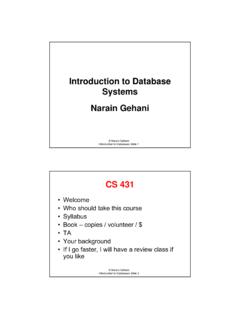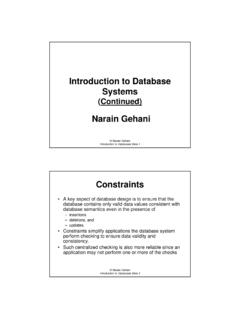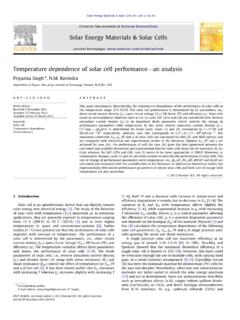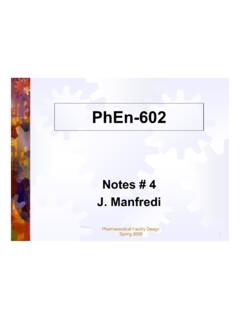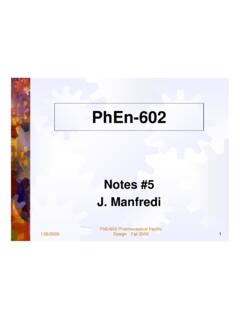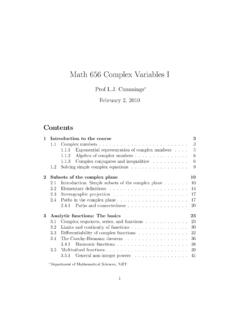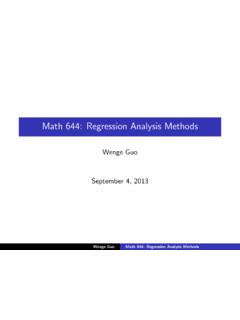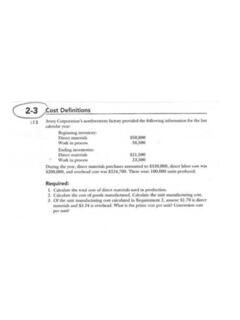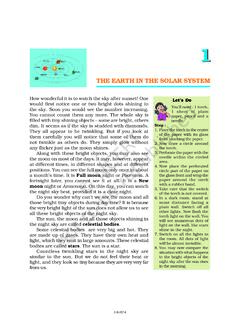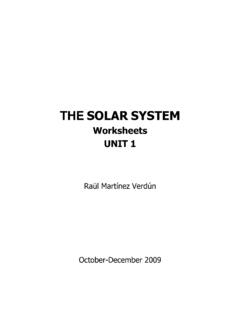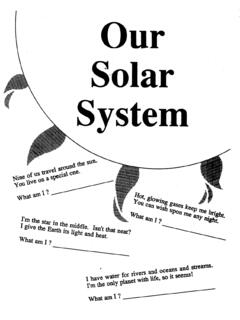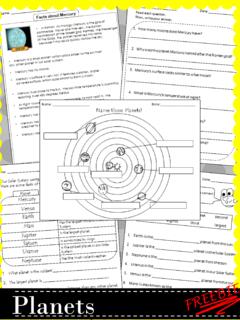Transcription of Our Solar System - New Jersey Institute of Technology
1 Our Solar System Lecture 8 The Cassini Jiong Qiu, MSU Physics Department Guiding Questions 1. Are all the other planets similar to Earth, or are they very different? 2. Do other planets have moons like Earth s Moon? 3. How do astronomers know what the other planets are made of? 4. Are all the planets made of basically the same material? 5. What is the difference between an asteroid and a comet? 6. What determines whether a planet or satellite can retain a certain gas in its atmosphere? 7. Why do interplanetary spacecraft carry devices for measuring magnetic fields? Current, Future, and Past Solar System Missions Planetary exploration missions are conducted by some of the most sophisticated robots ever built. Through them we extend our senses to the farthest reaches of the Solar System and into remote and hostile environments, where the secrets of our origins and destiny lie hidden.
2 The coming years of Solar System exploration promise to be the most exciting and productive yet, as we explore entirely new worlds and probe in even greater detail the fascinating environments we have discovered. We will learn the motion, structure, atmosphere, magnetic field of the Sun, planets, and satellites, and how to observe them. We will learn how to explain them -- gravity, energy, and nature of light. We will learn why our planet, the Earth, hosts life. Solar System q The star we call the Sun and all the celestial bodies that orbit the Sun n including Earth and other seven planets n all their various moons n smaller bodies such as asteroids, comets, meteoroids and dust Mercury, Venus, Earth, Mars, Jupiter, Saturn, Uranus, Neptune, (Pluto). (MVEMJSUN My Very Easy Method Just Seems No Use) According to their orbits, planets fall into two classes: the inner planets (Mercury, Venus, Earth, and Mars) are Earthlike, and the outer planets (Jupiter, Saturn, Uranus, and Neptune) are Jupiter like.
3 Planets The four inner planets are called terrestrial planets Relatively small: Earth is the largest Low mass: Earth is the heaviest High densities (4000 to 5500 kg/m3) with iron cores Composed primarily of rocky materials with solid surface the terrestrial (inner) planets The four gas giant outer planets are called Jovian planets Large diameters (4 to 11 times Earth s size) High mass (14 to 318 times Earth s mass) Low average densities (700 to 1700 kg/m3) Composed primarily of hydrogen and helium without a solid surface Jupiter is the largest and the most massive! the Jovian (outer) planets Pluto is a special case Smaller than any of the terrestrial planets Intermediate average density of about 1900 kg/m3 Its density suggests it is composed of a mixture of ice and rock Pluto special case: no longer a planet! Distance and size, drawn to scale.
4 Q: how do we know the composition of planets? The terrestrial planets ( = 4000-5500 kg/m3) are made of rocky materials and have dense iron cores. The Jovian planets ( = 700-1700 kg/m3) are composed primarily of light elements such as hydrogen and helium. =MV=M43 R3 Average density of water: water = 1000 kg/m3 Average density of metal: metal = 13,000 kg/m3 Average density of rock: rock = 3000 kg/m3 The average density gives a rough idea of the composition of a planet. = density, M = mass of the object V = volume of the object = 4 R3 / 3 (for spheres) R = radius of the spherical object Comparable in size to the planet Mercury The remaining satellites of the Solar System are much smaller satellites, asteroids, and comets - All the planets except Mercury and Venus have satellites. - More than 130 satellites are known. Jupiter has more than 60.
5 - Seven large satellites are almost as big as the terrestrial planets. - Ganymede and Titan are the largest; Titan has an atmosphere. Earth s diameter is 12,800 kilometer, twice that of Titan. Asteroids are small rocky objects, orbiting the Sun at distances of 2 to AU in `the asteroid belt , between Mars and Jupiter. Asteroid 433 Eros Hubble Space Telescope observed rotation of the mini planet Ceres, the largest asteroid (diameter = 900 km) in the asteroid belt. Water may exist beneath its surface. Asteroids in the distance by HST. (R. Evans, & )- Comets and other Kuiper belt objects are made of dirty ice. - The Kuiper belt extends far beyond the orbit of Neptune. - Pluto is the largest member of the Kuiper belt. o Both ateroids and comets are remnants left over from the formation of the planets. o They all orbit around the Sun, following Kepler s laws. o Like the two categories of planets, asteroids are more terrestrial , comets are Jovian.
6 Comet Hale-Bopp Copyright of the UK SchmidtComet Halley asteroid belts Kuiper belt and Oort cloud Q: What s the difference between planets, satellites, asteroids, and comets? 1. Satellites orbit around planets, planets orbit the Sun. 2. Asteroids and comets also orbit the Sun, but they are not large enough to become planets. 3. Asteroids locate in the asteroid belt between Mars and Jupiter. Comets are in Kuiper belt beyond Neptune. 4. Comets are likely extra- Solar System objects! Orbits of Planets - Kepler s laws Most planets orbit the Sun in the same direction and in almost the same plane: ecliptic is the plane of the Earth s orbit. Most planets have nearly circular orbits - the eccentricity of the orbit is very small. The farther away from the Sun, the longer the orbital period: Kepler s third law: P2 = a3 (P = sideral period, in year, a = semimajor axis of orbit, in AU) (from Arizona State U.)
7 Saturn s distance to the Sun is about 10 AU. A year on Saturn is as long as how many Earth year? Newton/Kepler s law determines the planet mass FG=GmMr2F = gravitational force between two objects (in newtons) m = mass of the planet (in kilograms) M = mass of the Sun (in kilograms) r = distance between planet and Sun (in meters) G = 10 11 newton m2/kg2 , universal constant of gravitation Newton s Law of Universal Gravitation accounts for Kepler s laws and explains the motions of a binary System . Newton demonstrated that Kepler s third law follows logically the law of gravity, and can be re-written as: a3=GM4 2# $ % & ' ( P2P = sidereal period, in seconds a = semimajor axis, in meters M = mass of the Sun, in kg G = universal constant of gravitation = x 10-11 The gravitational (pull or attractive) force keeps the planets orbiting the Sun. Newton s form of Kepler s third law F=m 2r=4 2mrP2=FGThis same relation is used to describe a satellite orbiting a planet.)
8 P2 = a3 The further away from the sun, the longer it takes to finish one orbit. Kepler s law also applies to asteroids and comets, all Solar System objects that orbit the Sun. Newton s law of the universal gravitation accounts for Kepler s laws. Newton demonstrated that Kepler s third law follows logically the law of gravity, and can be re-written as: a3=GM4 2# $ % & ' ( P2P = sidereal period, in seconds a = semimajor axis, in meters M = mass of the Sun, in kg G = universal constant of gravitation = x 10-11 The gravitational (pull or attractive) force keeps the planets orbiting the Sun. Newton s form of Kepler s third law F=m 2r=4 2mrP2=FGScaling the equation to Sun-Earth System : Kepler s third law. The atmosphere is retained by gravity Whether gases can stay in a planet s atmosphere depends on the combination of the following three factors: o planet s mass and size: gravity can retain gas particles.)
9 O gas composition: light gases run faster than heavy gases. o temperature: gases at higher temperature run faster. When an object has a high enough speed, it can escape from the planet s gravity (think about how we launch a rocket). The escape speed is: M = mass of the planet(kg); R = radius of the planet(m); G = gravitational constant = x 10-11 N m2/kg2. vesc=2 GMR(see Box for escape speed at each planet) A good thumb rule goes: If 6 vth > vesc , the particles (atoms or molecules) escape. If 6 vth < vesc , the particles (atoms or molecules) stay! The average speed of a gas at a temperature is given as: m = gas mass(kg); T = temperature (K=kelvins); vth = speed (m/sec); k = Boltzmann constant = x 10-23 J/K vth=3kTm" # $ % & ' 1/2(thermal speed) (optional) Maxwellian distribution of particles in thermal equilibrium. Q: among 8 planets, 1 does not have appreciable atmosphere.
10 Which one and why? Gas particles with smaller mass (m), less likely to be retained. Higher temperature, less likely to retain a gas. Planet of larger mass (M), more likely to retain a gas. Gravity and distance to the Sun are crucial! Terrestrial planets: high temperature, weak gravity, so low mass gases escape and massive gases stay. Jovian planets: low temperature, strong gravity, can retain even very light gases, , hydrogen and helium. 6vth=63kTm" # $ % & ' 1/2 vesc=2 GMREx 2: compare the abilities of Earth and the Moon to retain molecular oxygen (O2) gas in the atmosphere. (see ) Tesc>154 GMmkRescape temperature: We may calculate the escape temperature for molecular oxygen on Earth and on the Moon. For Earth, Tesc = 4500 K, much greater than Earth s mean temperature. And for the Moon, Tesc = 200 K, smaller than the Moon s mean temperature. Therefore, molecular oxygen gas is retained on Earth but not on the Moon.
